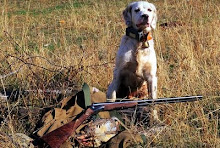Jessi was delivered from Harris Kennels, Fort Scott, Kansas, October 10, 2012, via Delta Air Cargo. Her lineage is what drew my attention to the breeding; her Sire a frozen semen son of HOF Ch. Guard Rail x Kraftsman's Ko Kane, her Dam coming from Pike Creek breeding's to Ch. McAdditional Class, Ch. Pike Creek Mike, and HOF Ch. Additions Go Boy, the bitches bread to these sires all being of Fiddler stock (Ch. Fiddlin' Rocky Boy and Ch. Fiddler's Ace). Her training to this point is as follows:
Jessi was about 10-weeks old when I picked her up. Her yard work started upon her arrival to my kennel with a new collar and an introduction to her crate; the collar established a point of contact, the crate a place of security and rest. I am fortunate that I could take her to work with me, by doing so I fed her 3-times a day, let her out every couple hours for exercise, and got her accustomed to her crate.
At 12-weeks of age I fastened a short check-cord (piece of 1/4" nylon rope) to her collar, just long enough to be dragged between her rear feet. She dragged it wherever she went, slept with it, and basically broke herself to the lead. This is important because when the pup goes to the field she'll be check-corded or running with the cord in search of birds. If she didn't have the association with the check-cord prior to go to the field she would be fighting the cord and not hunting birds. The next month consisted of, continued socialization, riding on the ATV, formal crate training, initial recall work, walking, and learning how to stand on objects; board, barrel, bench.
At 4-months old she was pulling pretty hard on the lead so I introduced the half-hitch around her waist. This introduction was important because her initial whoa-work will be done from this point of contact. The half-hitch also gives some relief to her neck when she is pulling. At this time, the game of standing on objects became more demanding and she experienced her first bit of pressure; the half-hitch is pulled up, the chin bumped with a short piece of PVC to get the head up, and a moment of steadiness is requested. There is no talking at this time, no verbal commands. In the field she was running and bumping, having a good time, becoming bold. When she came in from a cast I would throw a pigeon and let her chase; doing this, the pup associates birds with the field and me, and keeps to the front, which is where I want her.
In the picture above Jessi is just over 5-months old. She has learned to accept the pressure of being stacked-up; her head and tail are both high, her head forward, and she is steady, stylish. Initially the pup will tuck it's tail, not want to stand still, and constantly move it's head. Sooner or later, after a lot of bumping, lifting, and stroking, it all comes together. When we go to the field now she makes her initial cast and comes back to me, about ten yards out she stops with head and tail high, and I throw her a bird; her reward for standing with style.
Putting a good foundation in a pup is the key to successful training. The building blocks that support the foundation are established incrementally and placed in sequence, so that when you have a sticking point you can take a small step back and do not have to apply more pressure than necessary to get the job done. Minimizing pressure will keep a pup stylish and upbeat.
At about 6-months of age I will begin her collar conditioning, start formalizing her whoa work, and begin introducing pigeons in launchers in her field work. JT
Space Travel
10 hours ago









2 comments:
Terrific looking pup, Jared. I look forward to seeing her next season as a derby.
Good luck!
We'll see. JT
Post a Comment